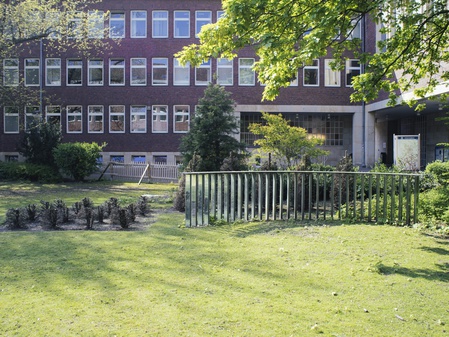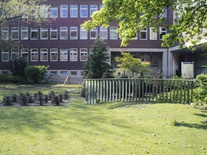Harald Klingelhöller
Die Wiese lacht oder das Gesicht in der Wand [The Meadow Smiles or the Face in the Wall]
1987
Mirrored glass, metal construction, 21 Taxus baccata [European yew]
Dimensions of mirrored glass construction: 150 x 400 x 20 cm
Location
Inner courtyard of the Juridicum, Faculty of Law of the Westfälische Wilhelms-Universität Münster [Münster University], Universitätsstraße 14–16, permanent installation
Owner
Westfälische Wilhelms-Universität Münster
Harald Klingelhöller
* 1954 in Mettmann, Deutschland
lebt und arbeitet in Düsseldorf
Harald Klingelhöller’s contribution to Skulptur Projekte in Münster 1987 coincided with the redesigning of the inner courtyard of the faculty of law. In addition to necessary restoration work in the courtyard, the ground plan and layout of paths were completely re-shaped, with the idea of counteracting the hierarchical rigidity of the building complex. Klingelhöller aligned his sculpture including its plants with the new courtyard complex to correspond to the architecture’s axes. He created an ensemble of altogether 16 spherical and five pyramid-shaped yews, completed by a curved railing-like construction consisting of mirrored glass.
The ensemble was inspired by objects which he exhibited in the Westfälische Landesmuseum’s historical atrium in 1985, independent of Skulptur Projekte. Even though this earlier ensemble had been conceived for an interior space, it consisted of components designed for an exterior space. These comprised coloured plaster spheres and pyramids together with a mirrored railing. Klingelhöller pursued various designs until finally in 1987 plans for his installation in the exterior space were completed. All the work’s components are based on the fundamental geometrical forms of the circle and triangle, for example the circle also appears as a segment in the curved railing of mirrored lamellas.
The first part of the work’s title, the sentence “Die Wiese lacht” [The Meadow Smiles], makes specific reference to Ernesto Grassi’s remarks on rhetoric.1 However, the apparent narrativity of the title does not describe the work in an explanatory manner. Klingelhöller employs language and sculpture as independent means of expression, so that figurative associations inevitably arise when simultaneously looking at the work and considering the title. For example the reflections of the spherically cut yews in the mirrored railing could be perceived as “faces in the wall”.
Marijke Lukowicz
1 Friedrich Meschede, Parallelen. In: Klaus Bußmann and Kasper König (eds.), Skulptur Projekte in Münster 1987, exhib. cat.: Westfälisches Landesmuseum für Kunst und Kulturgeschichte, Münster, Cologne 1987,162; see also Ernesto Grassi, Macht des Bildes. Ohnmacht der rationalen Sprache. Zur Rettung des Rhetorischen, Cologne 1970.
Location
- Still existing / Public Collection
- Removed
- In the museum

